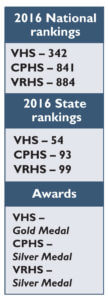

By KIM ESTES, Four Points News
Vandegrift High School has earned its third gold medal distinction in three years from U.S. News and World Report and numbers 54th among 466 ranked Texas high schools.
“It’s an honor and source of pride to be awarded a Gold Medal,” said Charlie Little, VHS principal.
“Our programs at VHS continue to grow and thrive because we have amazing students, supportive parents, passionate teachers and the Hill Country Education Foundation and Leander Educational Excellence Foundation that provide resources to support our innovation,” Little said.
Little noted many Texas schools that ranked above VHS were magnate or charter schools that have an application process and select students based on pre-determined criteria, making them more exclusive compared to traditional public schools.
“At Vandegrift, we are going to educate any student who walks in the door. If you remove the majority of these schools from the comparison, we are actually the #5 public comprehensive high school in Texas,” Little said.
The four ahead of VHS are: #26 – Highland Park, Dallas, #34 – Lovejoy, Lucas, TX, #41 – Westwood, Round Rock ISD and #45 – Westlake, Eanes ISD.
U.S. News and World Report ranks the best high schools in the nation each year. Of 19,908 eligible high schools, VHS came in at #342 in the U.S. It has had a broad range of national finishes in the past, including 347th in 2014 and 437th in 2015.
State rankings are based on a school’s national position. If the highest-ranked high school in a state is #60 nationally, then that school is ranked 1st in that state; if the second highest-ranked school in that same state is #1,201 nationally, then it is ranked 2nd in that state.
U.S. News teamed with RTI International, a global nonprofit social science research firm, to produce the rankings using a four-step process and data from 2013-2014.
The first two steps used performance results on state math and reading proficiency tests. Employing a sophisticated scoring method, among the considerations factored in were the percentages of the school’s economically disadvantaged students and whether or not they outperformed disadvantaged students in the state.
In the third step, graduation rates were considered. Although there was some variation in how states calculated graduation rates, the foundation of all states’ computations was the percentage of first-time 9th graders obtaining diplomas four years later. VHS had a 98 percent graduation rate in 2014.
The fourth step assessed the degree to which schools prepared students for college-level work using Advanced Placement or International Baccalaureate test data, depending on which program was the school’s largest. At VHS, the AP program was the largest with a 74 percent participation rate.
Then, officials nationally ranked the 6,218 highest-scoring schools as gold, silver or bronze depending on their college readiness index. The CRI is based on AP exam participation rates and percentages of students passing at least one exam. VHS posted a CRI of 61.9 percent.
“At VHS, we welcome any opportunity to compare our students on the national and state stage and look for ways to continuously improve the education of our students so they can compete at any level,” Little said.
He further noted that U.S. News based the rankings methodology on principles that a high school must serve all of its students well, not just those who are college bound, and that it must be able to produce measurable academic outcomes to show it is successfully educating students across a range of performance indicators.
In Leander ISD, Cedar Park High School was ranked #93 in the state and Vista Ridge High School was ranked #99. Each earned a silver medal.
Although VHS has earned a Gold Medal for the past three years, its state rank has dropped from 41st in 2014 to 52nd in 2015 and, this year, to 54th.
As to the decline in the last year, Little said, “To drop by two schools out of 1,915 (total number of high schools in the state), is not statistically significant. Typically, when the state adds another magnet or charter school to the list, numbers can move a little up or down, depending on the score of that school.”

